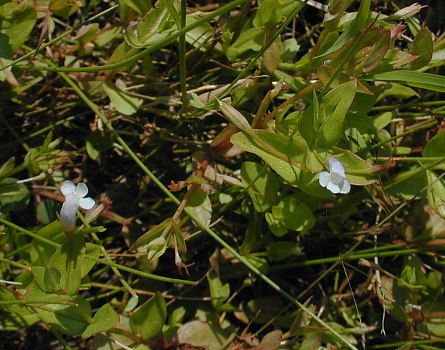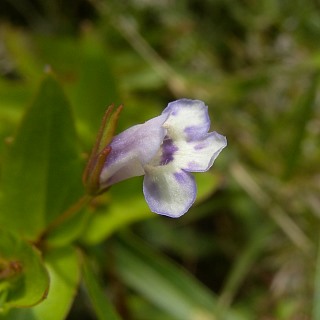Description: This plant is a summer annual about 4-8" tall that branches occasionally. The stems are light green to reddish green, 4-angled, and hairless. The opposite leaves are up to 1½" long and ¾" across; they are oval-ovate in shape, light green to reddish green, hairless, and smooth along the margins or bluntly dentate. The upper surface of each leaf has 3-5 pale veins, while the base of each leaf is sessile or has a short petiole.

Individual flowers
are produced from the axils of the upper leaves (one flower per axil).
Each flower is up to 1/3" (8 mm.) long, consisting of a tubular calyx
with 5
linear teeth and a tubular corolla that curves slightly downward. The
calyx is light green to reddish green and hairless. The corolla is
white, pale violet, or a combination of these two colors. The upper lip
of the corolla has 2 small lobes that function as a protective hood,
while the lower lip of the corolla has 3 lobes that are rounded and
spreading. Inside the corolla, there are 2 fertile stamens, 2 sterile
stamens, and a single style. The slender pedicel of each flower is up
to 1" long; it is usually shorter than the leaf underneath the flower.
The blooming period occurs during the summer and early fall and can
last 2-3 months for a colony of plants. There is no noticeable floral
scent. Each flower is replaced by a narrowly ovoid or spindle-shaped
seed capsule containing several small seeds. Mature seed capsules are
about as long as the teeth of the calyx or slightly longer. The root
system consists of a branching taproot. This plant reproduces by
reseeding itself and occasionally forms colonies.
Cultivation:
The preference is full or partial sun, wet to moist conditions, and
soil that is muddy, sandy, or gravelly.

Range & Habitat:
The native False Pimpernel is fairly common in most areas of Illinois,
although it
is easily overlooked (see Distribution
Map). Habitats include muddy borders of ponds and streams,
gravelly seeps, sandbars in rivers, moist open woodlands, and ditches.
This small plant typically occurs in wet areas with low vegetation that
are prone to flooding during the spring.
Faunal Associations:
The flowers are visited by Halictid bees and other small bees for
nectar and pollen. Small butterflies and skippers also visit the
flowers for nectar. The low foliage of this plant along the margins of
streams and ponds provides cover for frogs and turtles. This kind of
vegetation enables such animals to blend into the background, while
allowing them to see the approach of prey or predators.
Photographic Location:
The photo of the plant colony was taken at the edge of a pond in
Champaign, Illinois, while the photo of the flower close-up was taken
on a sand bar along the Embarass River in Coles County, Illinois.
Comments:
This wildflower is rather cute-looking when it is viewed up-close. It
resembles several other members of the Figwort (or Snapdragon) family
that are small-sized and prefer wetland habitats. Plants in this group
have small tubular corollas and ovoid seed capsules; their corollas
lack nectar spurs. It is difficult to distinguish False Pimpernel from Lindernia
anagallidea (Slender False Pimpernel), except the latter has
pedicels that are longer than the leaves. Some authorities consider the
latter species to be a variety of False Pimpernel. False Pimpernel is
also somewhat similar to Gratiola spp. (Hedge
Hyssops) with white or pale violet corollas. However, there is a pair
of slender bractlets underneath each flower of the Hedge Hyssops, while
the flowers of Lindernia spp. (False Pimpernels)
lack such bractlets.